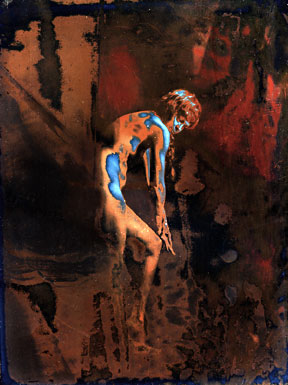 |
|||
|
|
|
Uranium by Robert W. Schramm
Most often it was used as a toner, producing red-brown tones on silver prints and blue, green and red tones on platinum prints. In 1858, J. C. Burnett and Niépce de Saint Victor patented a uranium printing process. A uranium print, which uses uranium metal instead of silver to form the image, is sometimes called a uranotype. Commercially made uranium printing paper was made until 1899. Uranium Toner Most toners either bleach or intensify a print. Silver prints to be toned in uranium must be printed a little lighter than usual since the toner will add density and contrast to the image. Also, as a general rule, prints to be toned should be completely fixed and thoroughly washed until all the hypo is removed. Toning works best if a non -hardening fixer is used. Toning is done with the lights on. The process is slow enough so that it can be done by inspection. A wet print is slid into the toning bath and left there until the degree of toning desired is
Figures 1 & 2 are uranium-toned silver prints using two different formulas for the toner. Uranium Prints (Uranotypes)
The first step in the process is making your own print paper. Mix the sensitizer (again wear protection) and coat some sheets of good watercolor paper with the sensitizer using a sponge brush or a Hake brush ( Do not use a brush with a metal ferrule). You can coat under dim incandescent light (15-40 watt bulb). Hang the paper up to dry in the dark. Let it dry naturally, do not use a hair dryer! When the paper is dry, it is ready to print. It does not store well, so you
Those of you who are alternative process printers should have no difficulty with this process. However, if you are new to alternative process printing, I would suggest you try something easier and less toxic first, like cyanotype, until you get the hang of dealing with the chemistry, making negatives and coating paper. I did a little survey a few months ago to see if there were any uranium printers besides myself and did not find any, so, should you decide to try this process, you will become a member of a very exclusive club. I will attempt to answer any questions you might have about uranium toners and uranium prints. My email address is: schrammrus@hotmail.com. Also, you can see more examples of my work at www.schrammstudio.com. There are several formulas for uranium toner and for making uranium prints. Here are two
that I have used and that work well. Mix each chemical into the water in the order in which they are listed.
Article and images copyright 2002 by Robert W. Schramm--all rights reserved. |
|||||||||||||||||||||||||||||||||||||||||||||||||||||
|
|
|
|



